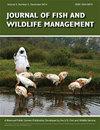Effects of Environmental Factors on Sucker Catch Rate, Size Structure, Species Composition, and Precision from Boat Electrofishing
IF 0.9
4区 环境科学与生态学
Q4 BIODIVERSITY CONSERVATION
引用次数: 0
Abstract
Catostomidae (catostomids) are suckers of the order Cyprinifores and the majority of species are native to North America; however, species in this group are understudied and rarely managed. The popularity in bowfishing and gigging for suckers in the United States has increased concerns related to overfishing. Little information exists about the relative gear effectiveness for sampling catostomids. Our study objective was to evaluate the relative effectiveness of boat electrofishing for sampling Black Redhorse Moxostoma duquesnei, Golden Redhorse M. erythrurum, Northern Hogsucker Hypentelium nigricans, White Sucker, and Spotted Sucker populations in Lake Eucha, OK. We used an information theoretic approach to determine the abiotic variables related to sucker catch per effort (C/f). Our analysis indicated that sucker C/f was highest during night and decreased with increasing water temperature. Sucker size structure was significantly different between daytime and nighttime samples; however, effect size estimates for size structure comparisons indicated size distributions exhibited moderate overlap. Distributional comparisons indicated daytime and nighttime samples were similar for fish >180 mm total length (TL). Effect size estimates also indicated little association between the proportion of each species captured and time of day or water temperature. Night electrofishing in reservoirs at water temperatures from 16-25 ⁰C yielded the most precise C/f estimates, with the highest numbers of suckers collected at water temperatures from 6-15⁰C. Further study of the relationship between abiotic variables and catostomid catchability using various gears would be beneficial to agencies interested in these populations.环境因素对渔船电捕鱼吸盘捕获率、大小结构、物种组成和精度的影响
鲶鱼科(鲶鱼目)是鲤鱼目的吸盘动物,大多数物种原产于北美洲;然而,这一群体中的物种研究不足,很少得到管理。在美国,弓钓和吸盘捕鱼的流行增加了人们对过度捕捞的担忧。关于猫造口术采样的相对齿轮有效性的信息很少。我们的研究目的是评估船电捕鱼对俄克拉荷马州欧几里得湖黑红马Moxostoma duquesnei、金红马M.erythrurum、北方猪笼草Hypentelium nigricans、白吸盘和斑点吸盘种群采样的相对有效性。我们使用信息论方法来确定与吸盘每次努力捕获量(C/f)相关的非生物变量。我们的分析表明,吸盘C/f在夜间最高,并随着水温的升高而降低。吸盘大小结构在日间和夜间样本之间存在显著差异;然而,尺寸结构比较的效应尺寸估计表明尺寸分布表现出适度的重叠。分布比较表明,总长度>180 mm的鱼类的日间和夜间样本相似。效应大小估计也表明,捕获的每种物种的比例与一天中的时间或水温之间几乎没有关联。16-25水温条件下的水库夜间电铸⁰C产生了最精确的C/f估计,在6-15的水温下收集的吸盘数量最高⁰C.使用各种齿轮进一步研究非生物变量与猫造口虫可捕性之间的关系,将有利于对这些种群感兴趣的机构。
本文章由计算机程序翻译,如有差异,请以英文原文为准。
求助全文
约1分钟内获得全文
求助全文
来源期刊

Journal of Fish and Wildlife Management
BIODIVERSITY CONSERVATION-ECOLOGY
CiteScore
1.60
自引率
0.00%
发文量
43
审稿时长
>12 weeks
期刊介绍:
Journal of Fish and Wildlife Management encourages submission of original, high quality, English-language scientific papers on the practical application and integration of science to conservation and management of native North American fish, wildlife, plants and their habitats in the following categories: Articles, Notes, Surveys and Issues and Perspectives. Papers that do not relate directly to native North American fish, wildlife plants or their habitats may be considered if they highlight species that are closely related to, or conservation issues that are germane to, those in North America.
 求助内容:
求助内容: 应助结果提醒方式:
应助结果提醒方式:


